Root crops such as carrots are widely cultivated worldwide for their fleshy, edible roots. A carrot is an annual or biannual herb that belongs to the Umbelliferae family. It is grown in temperate climate countries during spring, summer, and autumn and in tropical climates during winter. You can use carrot roots for soups & curries, graded roots for salads, and tender roots for pickles. In addition, it is sometimes used for coloring buffers and other food particles because carrot juice is a rich source of carotene.
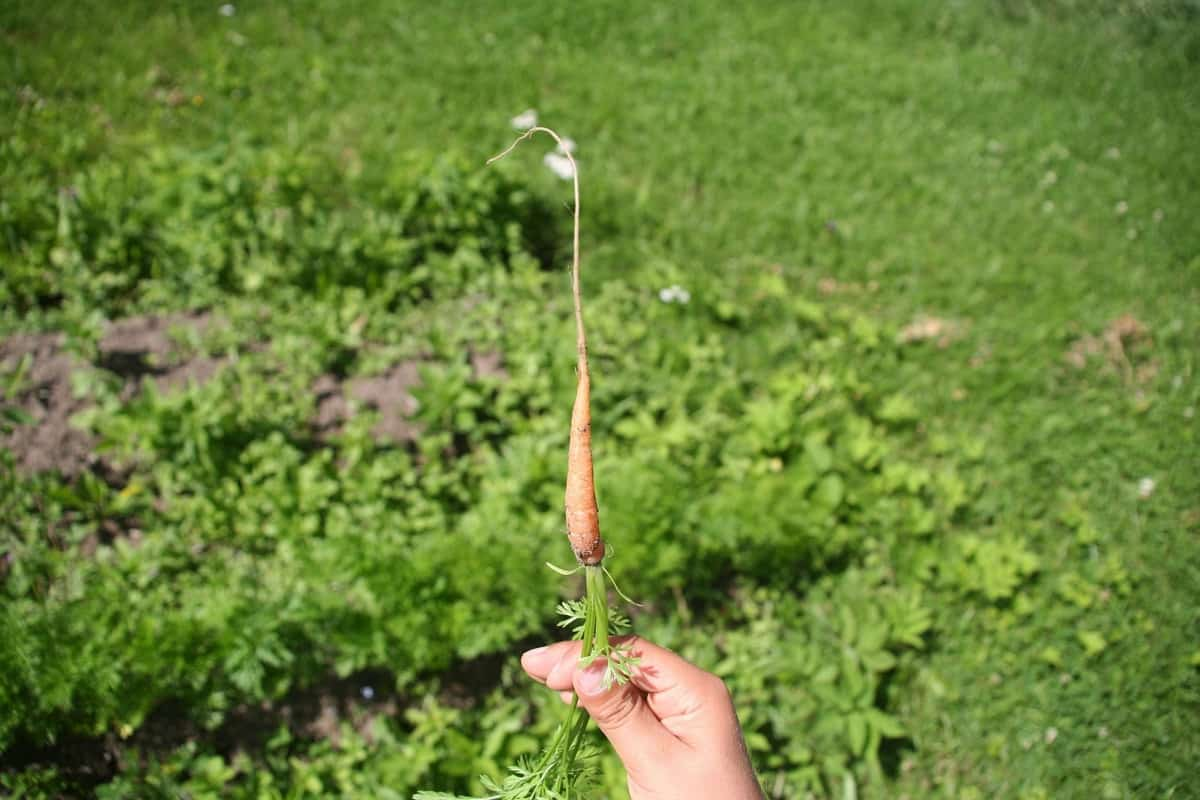
Furthermore, carrot tops can be used for leaf protein extraction, fodder, and poultry feed. Ayurvedic medicine uses carrots for their medicinal properties. Additionally, carrots contain plenty of thiamine, riboflavin, and b-carotene. Despite being popular worldwide, carrots rank second after potatoes in dietary consumption. In terms of production, China ranks first, followed by Russia. Several states in India grow carrots, including Karnataka, Punjab, Uttar Pradesh, Tamil Nadu, and Andhra Pradesh.
Growing Carrots organically in Punjab
How does the Punjab government support organic farming
The government of Punjab, through Punjab Agri Export Corporation Limited (PAGREXCO), is implementing the Organic Program and, through this, providing institutional support to the organic farmers of the State. They also train farmers for Organic Farm Management per organic certification standards and facilitate third-party certification. PAGREXCO also buys organic produce directly from certified organic farmers at remunerative prices and markets the products for domestic and foreign markets.
They also help farmers get a dedicated space allocated in government marketing yards/offices in cities for organic produce. To promote and popularize chemical-input-free farming, the government is implementing Paramparagat Krishi Vikas Yojana (PKVY) and Mission Organic Value Chain Development in North East Region (MOVCDNER). As part of such programs, clusters are formed, farmers are trained, organic inputs are procured, and on-farm preparation and marketing are provided.
Furthermore, farmers are provided subsidies under these schemes for organic inputs, including manure, worth Rs 12000/acre over three years under PKVY and Rs 13000/acre under MOVCDNER. Additionally, Bharatiya Prakritik Krishi Padhati (BPKP) will be implemented from 2020-21 as part of PKWY to promote traditional or natural indigenous practices. A major focus of this scheme is the exclusion of synthetic chemicals.
In case you missed it: How to Buy Agriculture Land in Punjab, and Who Can?
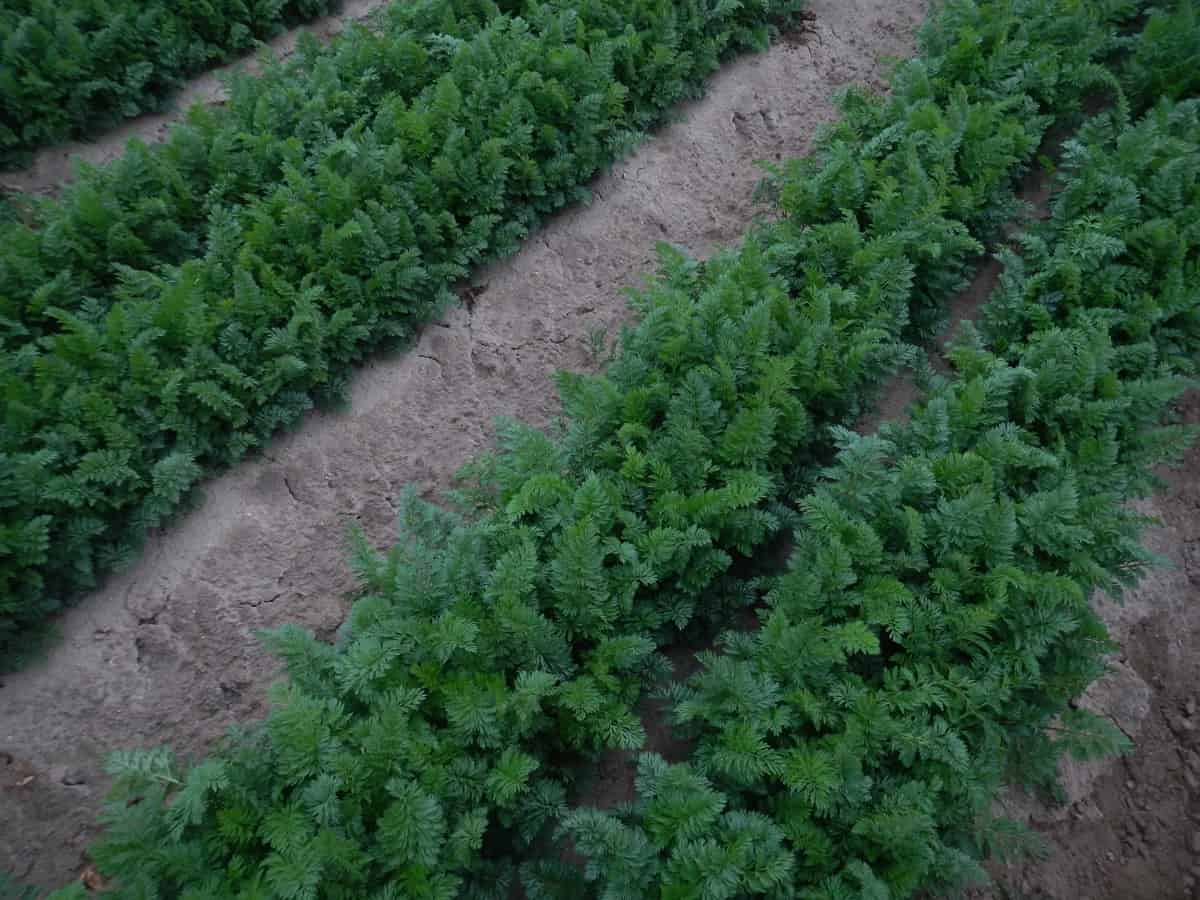
Moreover, it emphasizes biomass mulching, cow dung-urine formulations, and other plant-based preparations for on-farm biomass recycling. Cluster formation, capacity building, continuous handholding by trained personnel, certification, and residue analysis are all supported by BPKP under a financial assistance scheme of Rs 12,200 per acre for three years.
Soil requirement for Carrot farming
Many soil types are suitable for growing carrots. To grow carrots in a commercial setting, the soil should be deep, loose, well-drained, and humus-rich. Cultivating carrots is best done in soils with sufficient humus, such as loamy or sandy loam. A pH of 5.5-6.5 is ideal for obtaining a good yield. It can also be grown on soils with a pH of up to 7.0, but too alkaline or acidic soils are not appropriate
Climate requirement for Carrot farming
Despite being a cold-weather crop, carrots also do well in warm climates. Temperatures between 16 and 20°C are ideal for extraordinary growth, whereas temperatures above 28°C severely reduce it. A temperature below 16°C affects the development of color and results in long, slender roots, while a temperature above 16°C produces shorter, thicker roots. Roots with excellent red color and quality result from temperatures between 15°C and 20°C.
Propagation of Carrot seedlings
Seeds are used to propagate carrots. Based on the carrot variety, the seed rate for sowing or broadcasting carrot seeds varies from 2 to 2.4 kg/acre to 2.5 to 3.6 kg/acre. A gram of seeds contains approximately 800 seeds. Their viability lasts nearly three years, and 85% of them germinate. It may, however, be difficult for some local varieties to germinate.
Therefore, determining the germination percentage when calculating seed requirements is necessary. For best results, clean, healthy, and viable seeds need to be obtained from reliable sources. It usually takes seven to twenty-one days for the seeds to germinate completely. 20-30°C is the ideal temperature for seed germination. Thus, September is the best time to cultivate carrots in India.
Planting of Carrot
Getting the desired carrot yield requires proper preparation of the soil. The field must be loose, friable, deep, and well-drained for seeds to germinate. Several deep plowings at least 20-30 cm deep, followed by harrowing, leveling, and cleaning, can achieve this. For the seedbed to be in the desired condition, all old debris or remains from previous crops must be removed completely. Preparing the seedbed very finely is essential since the seeds are tiny and delicate. Before sowing, beds should be prepared in convenient sizes.
In case you missed it: Organic Farming In Punjab, How To Start
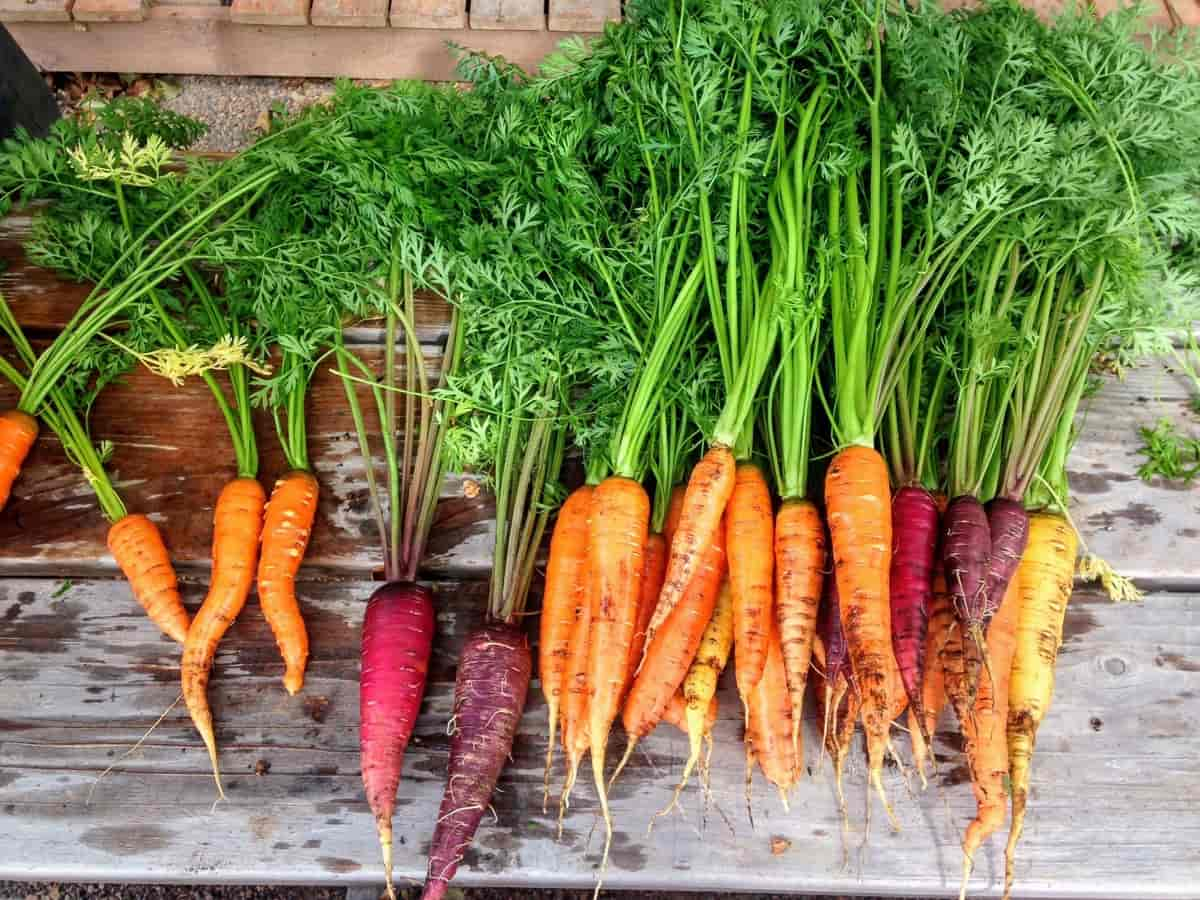
A mixture of sand, ash, or fine soil is mixed with seeds before broadcasting, drilling, or dibbling them by hand. A flatbed or ridges are used for sowing the seeds. A shallow furrow of 30-45 cm in length is made. Seeds are dibbled and sown with a spacing of 7.5-10 cm. Under such conditions, approximately 2-2.4 kg of seeds are needed per acre. Seeds are then lightly covered with soil or sand. Some growers irrigate the field approximately 24 hours before sowing to ensure adequate moisture. It takes about 10-15 days for most varieties to germinate.
Irrigation requirements in Carrot crop
Light irrigation should follow sowing immediately after sowing. Irrigation is continued as needed after that. Carrots with too much moisture have a light color and a larger diameter. Depending on the soil type, season, and variety, irrigation frequency varies. A single irrigation every 4-5 days during the summer and every 10-15 days during the winter are generally sufficient to keep the crop moist. It is only necessary to irrigate occasionally during the rainy season. Root cracking can be prevented by avoiding water stress during root development.
Application of organic fertilizers in Carrot cultivation
The carrot is one of the biggest potassium feeders. The plant’s roots can be affected by potassium deficiency, which can disrupt its overall metabolism. When roots are deficient in potassium, they are less sweet, and their flesh is less lustrous. Adding potassium-rich compost or manure to the soil is the most common method.
It will give the plants the nutrients they need to grow and thrive. Wood ash or greensand can also be added to the soil to treat potassium deficiency. As these materials are high in potassium, they will replenish the soil’s potassium reserves.
- Green manure of lupin 60 days before planting is recommended.
- Dissolve 30 grams of horn manure in 16 liters of water and apply it to the soil during land preparation.
- When preparing the ground, apply well-decomposed farm yard manure at 20 tons per acre.
- During land preparation, apply 2 tons of biodynamic compost per acre.
- At the time of land preparation, apply 2 tons of vermicompost per acre.
- When preparing the land, apply 500 kg of neem cake per acre.
- At the time of land preparation, apply biofertilizers, Azospirillum, and Phosphobacteria at 10 kg each.
- On the 45th, 60th, and 75th day after planting, spray the cow pat pit with 2 kg/acre in 40 liters of water.
Weeding in Carrot cultivation
- The first weeding should be done on the 15th day. Thinning and earthing up are to be given on the 30th day.
- Growth regulators.
- Use foliar spraying of panchagavya at 3 percent at ten days intervals from 1st month after sowing.
- Spray 10% vermiwash five times with 15 days intervals from one month after sowing.
- Foliar spray of horn silica at 2.5 grams/acre in 50 liters of water on the 65th day after sowing to increase the yield and quality of the carrot roots.
In case you missed it: Fish Farming In Punjab, How To Start, Tips, Ideas
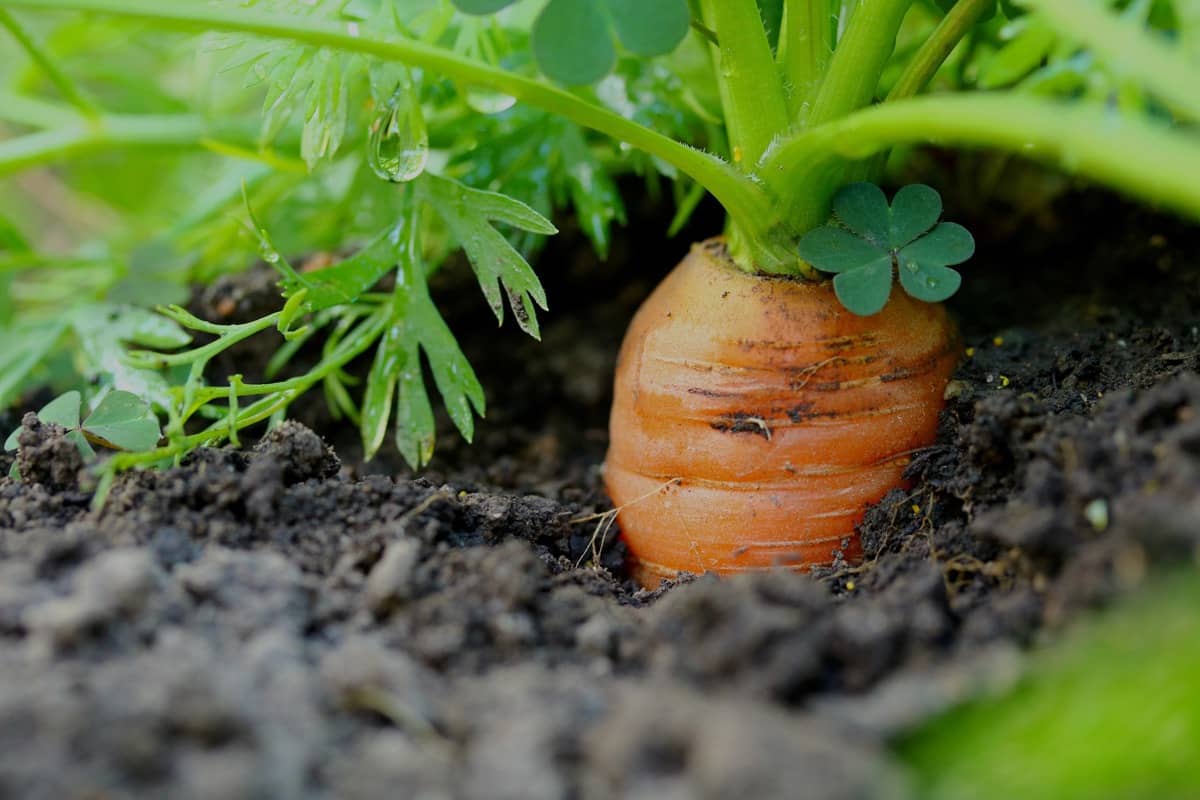
Diseases in Carrot cultivation and their organic control
Alternaria leaf blight
Disease symptoms
- Lesions on leaves are green-brown, enlarging, and becoming dark brown or black after being soaked in water.
- Leaves can turn yellow and die when lesions coalesce; petioles can also show lesions.
Control
- Seeds should be treated with hot water before planting.
- For upright growth and better air circulation, apply gibberellic acid to carrot foliage.
Black rot
Disease symptoms
- Shows damping-off of seedlings and root and crown necrosis.
- Blighted foliage and lower portion of petioles are black and necrotic.
- The black ring around the petiole attachment and black and sunken lesions on the taproot.
Control
- Treat seeds with hot water before planting.
- Practice long crop rotations and plow crop residue into the soil immediately after harvest.
Powdery mildew
Disease symptoms
- The leaves, petioles, flower stalks, and bracts look powdery.
- As a result of chlorotic leaves and severe infections, flowers may become distorted.
Control
- Spray with Baking soda liberally, getting top and bottom leaf surfaces and any affected areas.
- Remove the affected leaves, stems, buds, fruit, or vegetables from the plant and discard.
In case you missed it: Dairy Farming In Punjab, Breeds – How To Start

Pests in Carrot crops and their organic control
Aphids
Damage symptoms
- Small, soft-bodied insects are found on the underside of leaves of plants.
- A heavy infestation of aphids can result in yellow and distorted leaves, necrotic spots on leaves, and stunted growth.
- Honeydew is a sticky, sugary secretion by aphids that causes the plants to grow sooty mold.
Control
- It is usually best to control insects with neem, canola oil, or insecticidal soaps.
- A strong water jet can be sprayed on sturdy plants to knock aphids off their leaves.
Carrot rust fly
Damage symptoms
- Tunnels cause surface scarring of the taproot, and tunnels are filled with rusty mush.
- The adult insect is a small, dark-colored fly, and larvae are white grubs approximately 1 cm (0.3 in) long.
Control
- Plants can be protected from damage by using row covers, but they must be installed before adult flies lay their eggs.
- To reduce overwintering sites, harvest carrots in blocks and do not leave them in the ground over the winter.
Carrot weevil
Damage symptoms
- There are irregular dark grooves in a zig-zag pattern on the roots.
- The plant leaves may be yellow, and the adult insect is a dark-colored beetle.
- Larvae are white to pinkish-white C-shaped grubs with a yellow-brown head.
Control
- Remove all debris from Umbelliferous crops (e.g., parsley, dill, celery, etc.) to reduce sites where weevils can survive and persist.
- Try to rotate Umbelliferous crops to different areas each year to reduce the survival of larvae in the soil.
Weed control in Carrot cultivation
Most carrot crop weed control is done pre-planting, although cultivation is integral to organic carrot production. Growers often use flame-weeding technology for pre-emergence weed control because it doesn’t disturb the soil surface. In this method, timing is crucial, and only close monitoring of conditions will ensure the right timing. Seeding a sample of beets at the end of a carrot row is a standard method of estimating. Fields can be flame-weeded one or three days before the carrots emerge.
A post-emergence wedding can be a challenge for organic growers. Since carrots are small and grow slowly, they have little competitive advantage. By using basket weeders, tine weeders, or tender hoes/sweeps, shallow cultivation can be accomplished early on to manage between-row weeds. Between- and in-row weeding and covering carrot shoulders, finger weeders and more aggressive shovels and sweeps can be used as the crop grows. Hand weeding may be necessary depending on weed pressure and control methods.
In case you missed it: Fertilizer Management in Carrot Farming: Organic, NPK, How and When to Apply
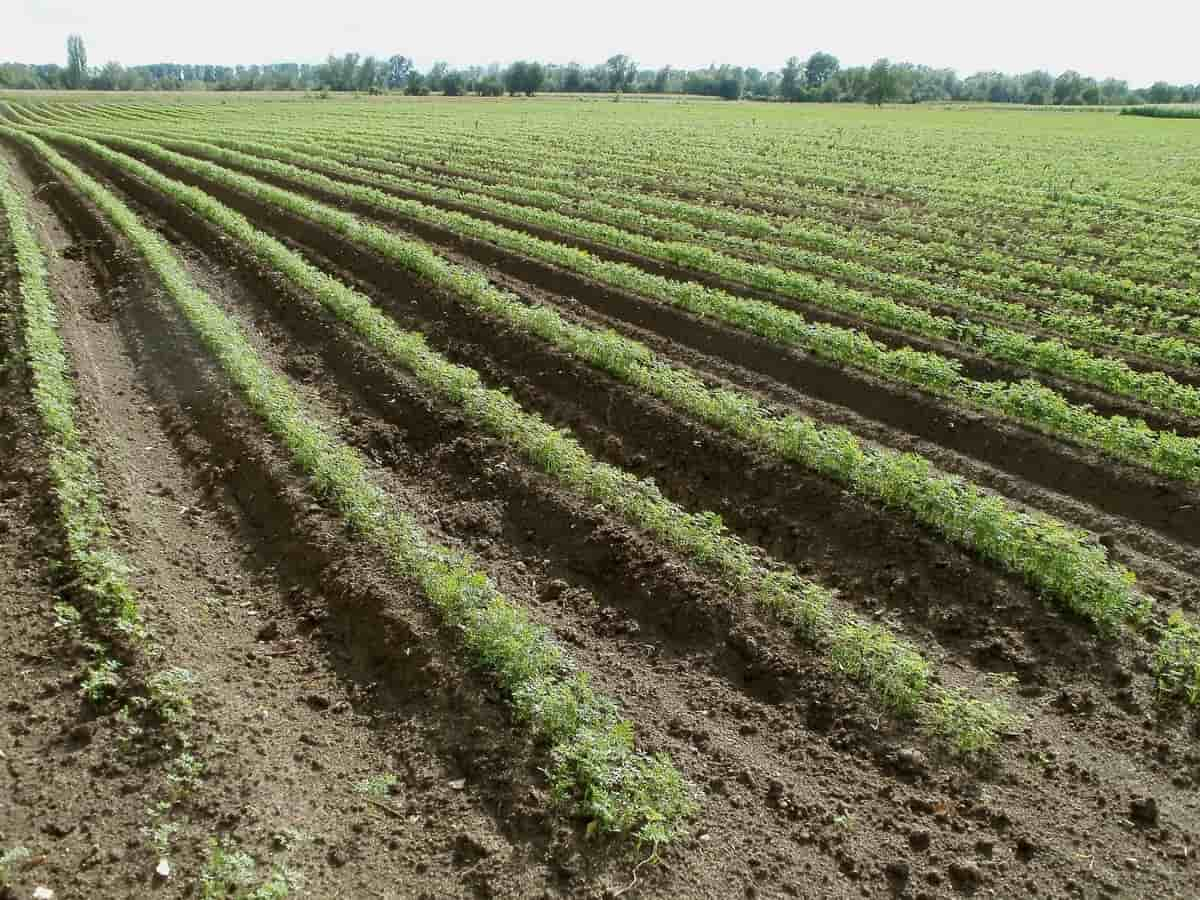
Harvesting carrot crop and its yield
Early carrots are harvested at a stage of partial development. They are retained in the soil for distinct markets until they reach full maturity. The full maturity stage, however, should not be retained because it becomes hard and unsuitable for consumption. You can estimate the root width by looking at the neck of the root. Two months after sowing, the first roots should be ready.
When harvested, the upper end of carrot roots should be 1.8 cm or larger in diameter. A carrot tastes better when it is smaller. The diameter of a carrot should be about 1/2 inch or as wide as your thumb. Irrigating the field once a day before harvest facilitates harvest. Younger, shallower roots should come off quickly when gripped firmly at the base of the foliage. It can be helpful to push down on the root first, then twist it as you gently pull upwards.
With a fork, you may need to ease up larger, longer roots, especially those of maincrop carrots sown for winter consumption. Special plows (carrot lifters) or ordinary plows can loosen the soil. Depending on the size of the roots, harvest them in stages. You will stagger your harvest over many weeks this way.
Harvesting carrots in the fall after one or more frosts makes them taste much better. You can harvest carrots later by covering the tops with shredded leaves after the first hard frost in the fall. It depends on the variety of carrots and how much yield is deferred. Tropical varieties produce 8 to 12 tons per acre, while temperate varieties produce 4 to 6 tons per acre.
Conclusion
During the growing season, carrots can be a profitable crop, but they can also be stored crops during the winter months, which helps keep relationships with customers consistent. It is possible to produce heavy yields of this universally loved vegetable with proper management.
- Types of Pesticides Used in Agriculture: A Beginner’s Guide
- Economical Aquaculture: A Guide to Low-Budget Fish Farming
- 15 Common Planting Errors That Can Doom Your Fruit Trees
- How to Make Houseplants Bushy: Effective Tips and Ideas
- Innovative Strategies for Boosting Coconut Pollination and Yield
- Pollination Strategies for Maximum Pumpkin Yield
- The Complete Guide to Chicken Fattening: Strategies for Maximum Growth
- Natural Solutions for Tulip Problems: 100% Effective Remedies for Leaf and Bulb-Related Issues
- Revolutionizing Citrus Preservation: Towards a Healthier, Greener Future
- Natural Solutions for Peony Leaf and Flower Problems: 100% Effective Remedies
- Maximizing Profits with Avocado Contract Farming in India: A Comprehensive Guide
- Natural Solutions for Hydrangea Problems: 100% Effective Remedies for Leaf and Flowers
- The Ultimate Guide to Choosing the Perfect Foliage Friend: Bringing Life Indoors
- From Sunlight to Sustainability: 15 Ways to Use Solar Technology in Agriculture
- The Ultimate Guide to Dong Tao Chicken: Exploring from History to Raising
- The Eco-Friendly Makeover: How to Convert Your Unused Swimming Pool into a Fish Pond
- Mastering the Art of Delaware Chicken Farming: Essentials for Healthy Backyard Flocks
- 20 Best Homemade Fertilizers for Money Plant: DIY Recipes and Application Methods
- How to Craft a Comprehensive Free-Range Chicken Farming Business Plan
- Brighten Your Flock: Raising Easter Egger Chickens for Beauty and Bounty
- How to Optimize Your Poultry Egg Farm Business Plan with These Strategies
- Subsidy for Spirulina Cultivation: How Indian Government Schemes Encouraging Spirulina Farmers
- Ultimate Guide to Raising Dominique Chickens: Breeding, Feeding, Egg-Production, and Care
- Mastering the Art of Raising Jersey Giant Chickens: Care, Feeding, and More
- Ultimate Guide to Raising Legbar Chickens: Breeding, Farming Practices, Diet, Egg-Production
- How to Raise Welsummer Chickens: A Comprehensive Guide for Beginners
- How to Protect Indoor Plants in Winter: A Comprehensive Guide
- Ultimate Guide to Grow Bag Gardening: Tips, Tricks, and Planting Ideas for Urban Gardeners
- Guide to Lotus Cultivation: How to Propagate, Plant, Grow, Care, Cost, and Profit
- Agriculture Drone Subsidy Scheme: Government Kisan Subsidy, License, and How to Apply Online
- Ultimate Guide to Raising Araucana Chickens: Breed Profile, Farming Economics, Diet, and Care
- Bringing Hydroponics to Classroom: Importance, Benefits of Learning for School Students
- Ultimate Guide to Raising Polish Chickens: Breed Profile, Farming Economics, Diet, and Care
- Ultimate Guide to Raising Australorp Chickens: Profile, Farming Economics, Egg Production, Diet, and Care
- Silkie Chicken Farming: Raising Practices, Varieties, Egg Production, Diet, and Care
- Sussex Chicken Farming: Raising Practices, Varieties, Egg Production, Diet and Care